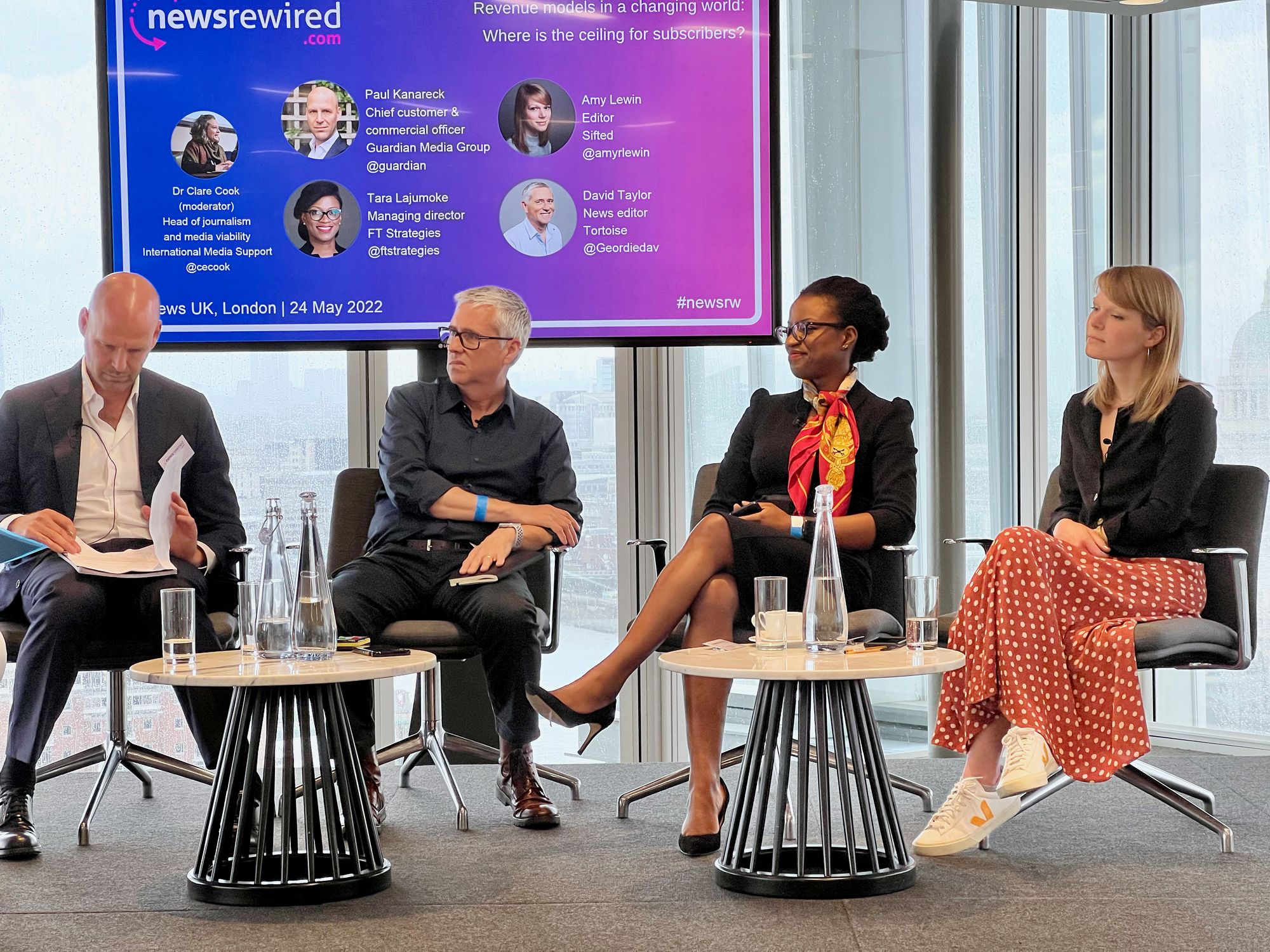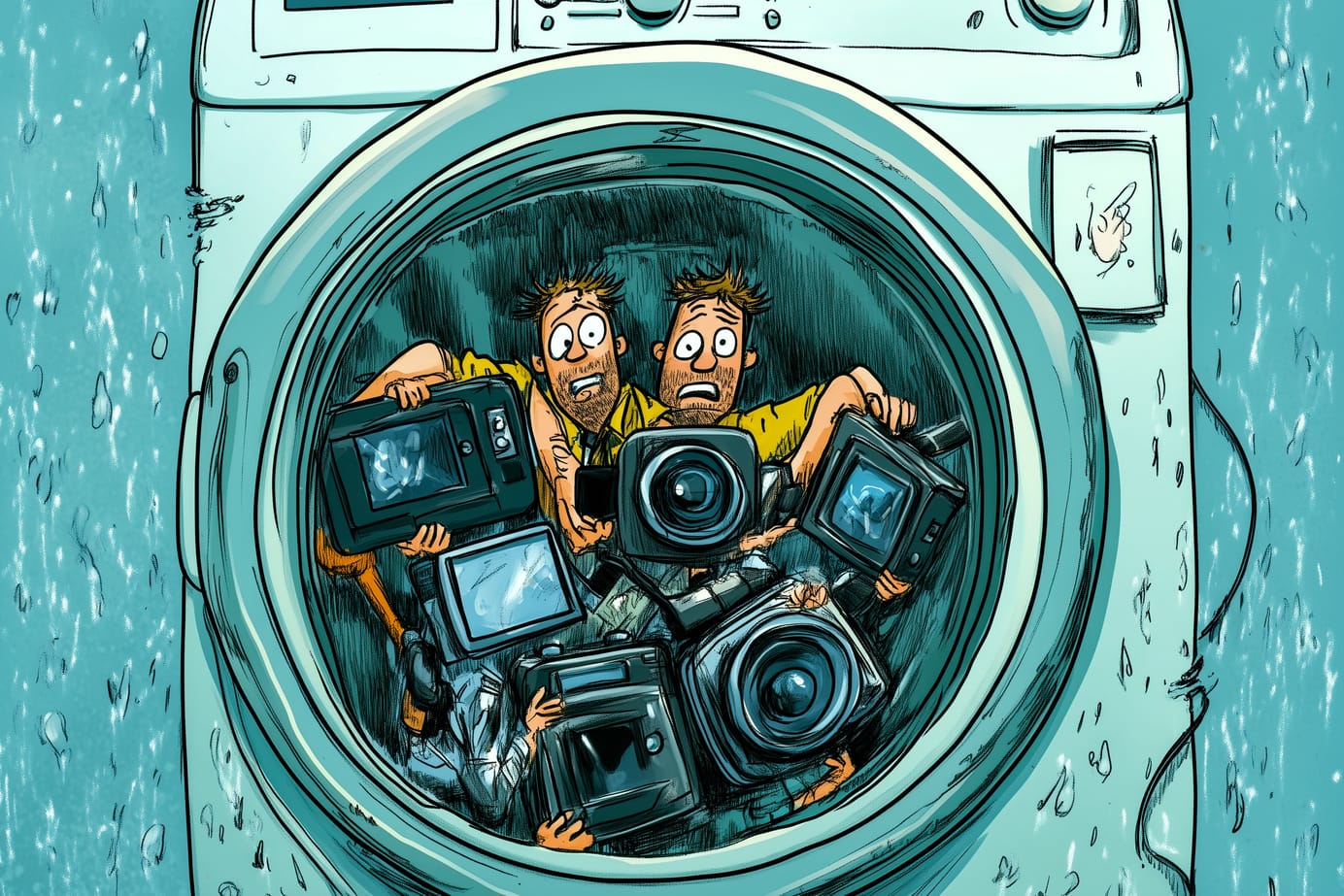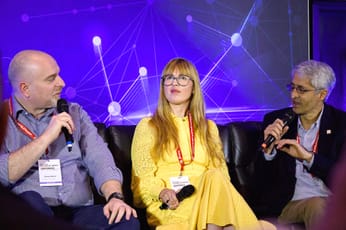
Subscriber revenue: what's the future — and the limit?
How do you win an audience. convert them to subscribers — and retain them in tough economic times? A news:rewired panel explores past sucesses and future strategies.
The pivot to audience revenue has been a dramatic trend over the past decade, accelerating during the pandemic. But with the cost of living on the rise, will readers start cutting back?
A panel at news:rewired explored strategies for staying ahead in a falling market.
The Panel
- Tara Lajumoke, managing director, FT Strategies
- Paul Kanareck, chief customer and commercial officer, Guardian Media Group
- David Taylor, news editor, Tortoise
- Amy Lewin, editor, Sifted
- Chair: Dr Clare Cook, head of journalism and media viability, International Media Support
Paul Kanareck, The Guardian

The Guardian is 201 years old, but is seven years into a reader-revenue first strategy – which was met with scorn and derision when it was announced. The original calculation was that if you reach mass digital reach, then the higher the volume of people you have, the more chance you have of monetising them. That’s gone really well. They did 16bn page impressions last year, and they’re converting well into supporters. They have multiple reader revenue products, from in-app subscriptions, to contextual marketing. Are people becoming numb to that? It varies globally. A lot of art and science goes into those marketing boxes – they A/B test everything.
They hit the 1m club of recurring supporters, and about 0.5m one-off supporters. And half the support base is outside the UK. Will the cost of living crisis impact subscriptions? Yes. People will probably go on a subscription diet – and the costs of using social to get customers are growing, too.
David Taylor, Tortoise

Tortoise is built on a slow news ethos, but also with a focus on deep community with their readers. They reach out to them through events like ThinkIns, which bring Tortoise members into face-to-face meetings, and online ones. They try to understand issues with a mix of expert voices and the readers. Furthermore, Tortoise is only three years old — a startup — and they survived the pandemic, which they’re proud of. Membership is built into the model from the start, it’s not an add-on.
Sweet Bobby, a podcast series they did, was an incredible success for them globally. When you have 8m people download that globally, some of them will become members. So, they’re seeing more and more members come in through Apple because of that. The podcast brought in people who had never heard of Tortoise. They’re not dependent on big hits — but 4k of their 55k came in through that route.
People are feeling the pinch — if they’re not using something, they will unsubscribe. The more transient the relationship, the more easily they’ll leave. Tortoise is responding with multiple ways to contact the title, a couple of newsletters and a podcast, for example, make a difference. Make them feel part of something.
Tara Lajumoke, FT

Over the past decade, the FT has transformed from an advertising and print model, to a digital and reader-revenue model. In 2010, over half their revenue was ads, and by 2020 it was down to a third. They’re trying to diversify their revenue, not just replace advertising with reader revenue.
As their revenue has grown, they’re reinvested in the business, on issues like first party data. They’re moving on from a scale-based North Star target of 1m subscribers, and switching to looking at value, and making more from their engaged readers. But are still continuing to grow. So, they’re trying both to reach new audiences and to deepen their relationship with existing readers.
FT Edit is a curated selection of hand-picked content at £4.99 – this is to reach more price sensitive readers, who won’t pay even £30 monthly for the standard offer.
Amy Lewin, Sifted

Sifted is a small, 13 journalist team, backed by the FT but independent of it, so they’ve been out there in the world of VCs seeking money. They’ve added a paywall, which has been a real learning journey.
“FOMO works amazingly. If people are worried their competitors know something they don’t, and it’s behind a paywall, they will pay for that,” Lewin says.
They have monthly and annual memberships — but they think about the style of articles that keep people subscribing. Most revenue is still newsletter and events sponsorship – membership revenue is small but growing. They have a premium offering, which is a more negotiated fee per corporate customer.
What content wins subscribers?
The Guardian tries to avoid the word subscriber — they’re supporters, who value special moments and investigations. Paul thinks that the market has been hooked on volume, rather than value. Now, the market is finally wising up to that. For the last decade, Netflix subs have been subsidised by Wall Street debt, but that’s coming to an end now.
David certainly believes that the free content does convert to members. The beating heart, though, is the community network, which brings a plurality of voices into the mix.
Amy thinks that membership growth is dependent on getting close to the readers, and working out what they want, not just what they say they want.
Why does the FT “relax” its paywall? Simple, says Tara: the best way to sell your journalism is through your best journalism. Subscribers can “gift” articles to other people.
Investigations are increasingly more important, thinks Paul. Holding power to account is increasingly expensive – but ever more essential. It’s about making the news, not just waiting for it to happen. When they do stories like that, they try to launch them across the newsletters, the podcast, the app and so on…
Strategies for economic headwinds

- Amy: Tech stocks have crashed – so there’s loads for us to report! So, we have to find the information no-one else has, and set up the membership offers around that.
- Tara: Churn management, and increasing share of wallet. Understand what drive churn, using as broad a set of data as you can — and be more proactive at reposting to that.
- David: Great stories, told as well as we can. As we launch more multi-parters and “always on” podcasts, you multiply your download audience, and even a small percentage of them could make a difference to your membership numbers.
- Paul: Price is a dangerous lever — you can offer £6 for six months, m but at the end of that, they’re gone. Every supporter is important to us, wether they donate $1 or $100. Focus on a relationship, it’s much harder to break up when you’re in one…
Sign up for e-mail updates
Join the newsletter to receive the latest posts in your inbox.










